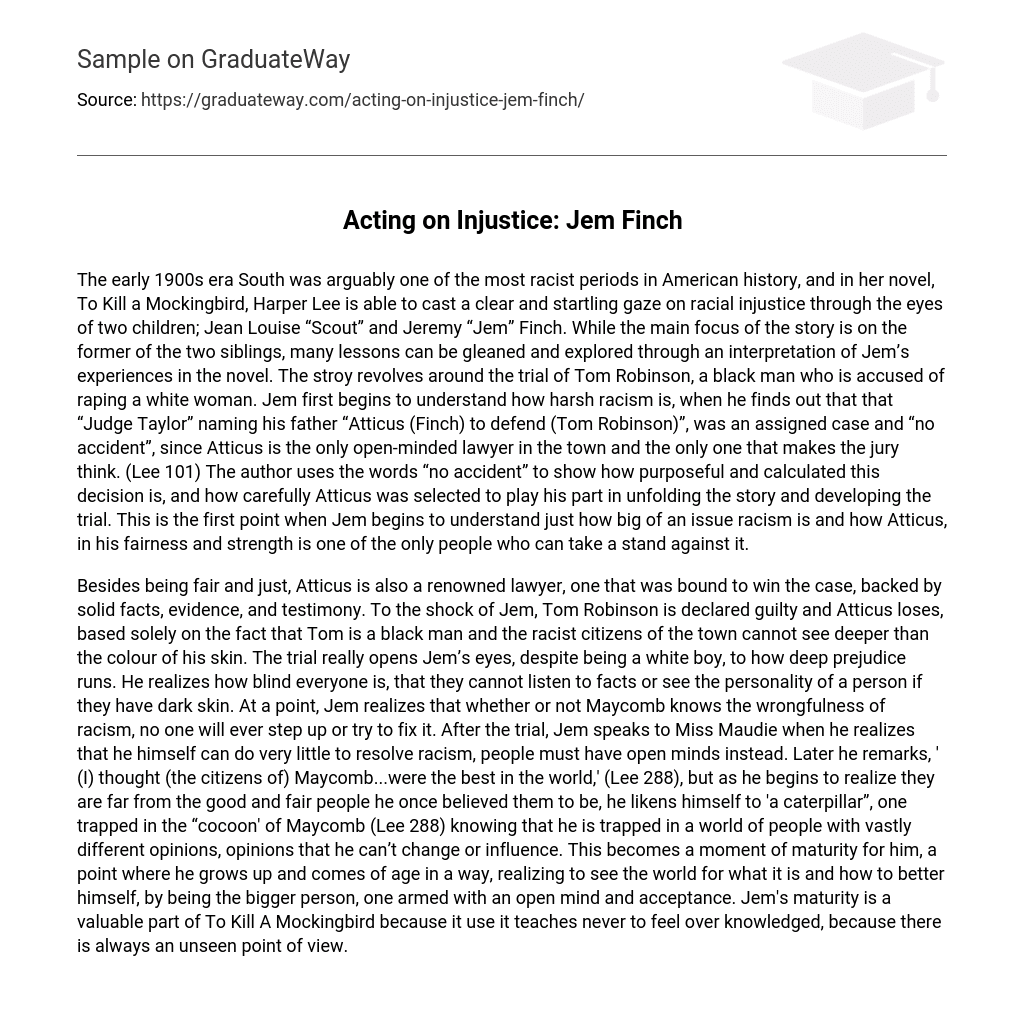The early 1900s era South was arguably one of the most racist periods in American history, and in her novel, To Kill a Mockingbird, Harper Lee is able to cast a clear and startling gaze on racial injustice through the eyes of two children; Jean Louise “Scout” and Jeremy “Jem” Finch. While the main focus of the story is on the former of the two siblings, many lessons can be gleaned and explored through an interpretation of Jem’s experiences in the novel. The stroy revolves around the trial of Tom Robinson, a black man who is accused of raping a white woman. Jem first begins to understand how harsh racism is, when he finds out that that “Judge Taylor” naming his father “Atticus (Finch) to defend (Tom Robinson)”, was an assigned case and “no accident”, since Atticus is the only open-minded lawyer in the town and the only one that makes the jury think. (Lee 101) The author uses the words “no accident” to show how purposeful and calculated this decision is, and how carefully Atticus was selected to play his part in unfolding the story and developing the trial. This is the first point when Jem begins to understand just how big of an issue racism is and how Atticus, in his fairness and strength is one of the only people who can take a stand against it.
Besides being fair and just, Atticus is also a renowned lawyer, one that was bound to win the case, backed by solid facts, evidence, and testimony. To the shock of Jem, Tom Robinson is declared guilty and Atticus loses, based solely on the fact that Tom is a black man and the racist citizens of the town cannot see deeper than the colour of his skin. The trial really opens Jem’s eyes, despite being a white boy, to how deep prejudice runs. He realizes how blind everyone is, that they cannot listen to facts or see the personality of a person if they have dark skin. At a point, Jem realizes that whether or not Maycomb knows the wrongfulness of racism, no one will ever step up or try to fix it. After the trial, Jem speaks to Miss Maudie when he realizes that he himself can do very little to resolve racism, people must have open minds instead. Later he remarks, ‘ (I) thought (the citizens of) Maycomb…were the best in the world,’ (Lee 288), but as he begins to realize they are far from the good and fair people he once believed them to be, he likens himself to ‘a caterpillar”, one trapped in the “cocoon’ of Maycomb (Lee 288) knowing that he is trapped in a world of people with vastly different opinions, opinions that he can’t change or influence. This becomes a moment of maturity for him, a point where he grows up and comes of age in a way, realizing to see the world for what it is and how to better himself, by being the bigger person, one armed with an open mind and acceptance. Jem’s maturity is a valuable part of To Kill A Mockingbird because it use it teaches never to feel over knowledged, because there is always an unseen point of view.





